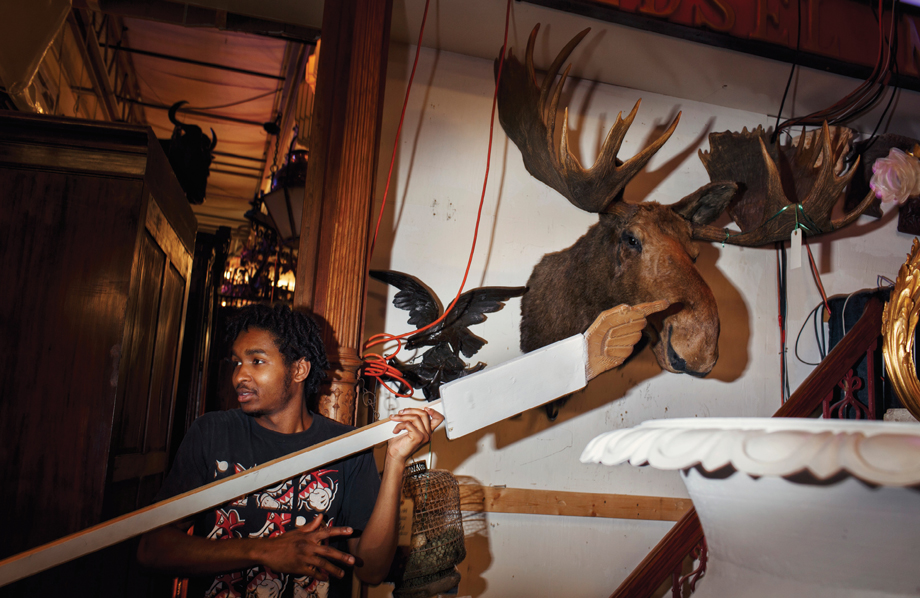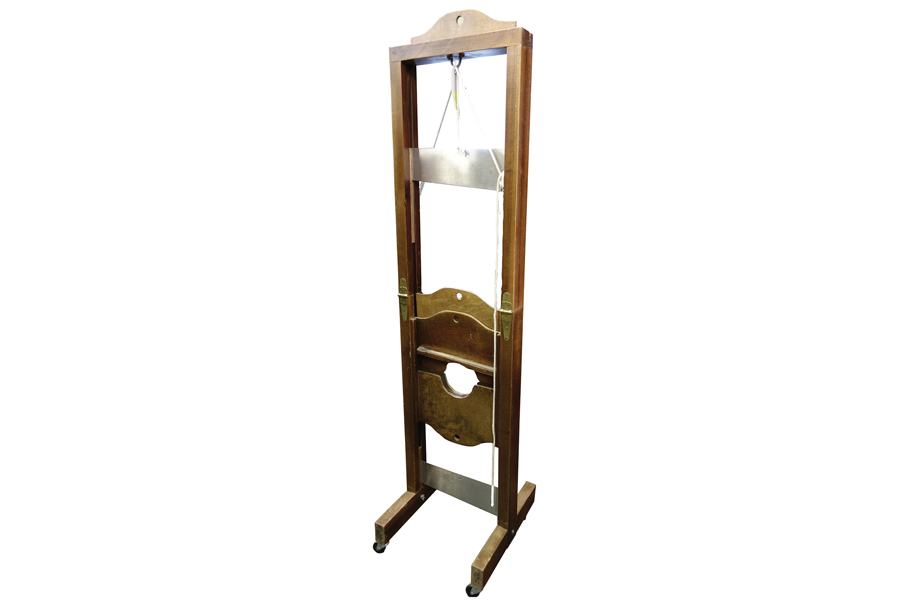
“There’s nothing here that anyone needs!” Bob Brown announces into his microphone as the crowd settles into their seats.
It’s an unconventional way to begin an auction—part reverse psychology, part challenge—but then Red Baron’s is not your conventional antique vendor. And, after 40 years in the business of selling unneeded and often outlandish objects to Georgia’s—and the country’s—rich and famous, it must be said that Brown certainly knows his customers.
Over the course of five hours on this rainy Tuesday evening in his 60,000-square-foot warehouse-cum-showroom on the northern edge of Sandy Springs, Brown and company will sell about 475 lots. The rat-a-tat pace is perfect for short attention spans, with much of the bidding taking a mere 30 or 40 seconds before it’s on to the next item.
There are no fussy Chippendale end tables or dainty Limoges tea sets to be had tonight. Instead the offerings mostly fall into two categories: eccentric and enormous. A Ms. Pac-Man arcade games goes for $350. A moose head with full antlers fetches $1,500. An old merry-go-round horse, a life-sized medical school organ model, and a trick guillotine from a traveling magic act fly by in quick succession.
Michael Healey, a pediatric dentist, says he’s been coming to Red Baron’s auctions for 25 years. His prize purchase was a fully operational 20-horse carousel that he had installed in a building attached to his office in Sandy Springs. Caroline Cox of Suwanee is looking for furnishings for her beach house. Of the 50 or 60 people in the audience, the majority are middle-aged or older; many appear well-heeled; and most are clearly here for the duration, getting up every now and then to get a burger from the short-order grill or grab a refill of the free beer and wine. When explaining why they come, auction attendees—including several who don’t want to give their names—are of one mind: It’s fun.
And no one seems to be having more fun than Woody Heath. Leaning back in his seat in the very center of the front row, he raises his bidding card every few minutes. A 100-year-old baby grand piano from Vienna. Two elaborately carved wooden cabinets so large they might only look at home in a castle. A 1983 Land Rover Defender driven into the auction hall through a side door that could accommodate a small aircraft. Heath, a compact man of advancing years with a wild mane of shoulder-length silver hair, grins like an impulsive child as he buys these and perhaps a dozen other offbeat items.
Even Heath has lost track of his tally of new possessions by the time the night’s last lot has been sold. Having made a fortune in the restaurant business, he bought a former textile mill complex in Griffin in which to store his collection of more than 100 vintage cars and countless other acquisitions.
“When I find something unusual, I get it,” he says as an associate goes to settle up the tab. “I’ve got buildings full of stuff, more than any white boy could hope to use in a lifetime.”
And there you have the ideal Red Baron’s customer.

Photograph by Melissa Golden
Bob Connelly, a top antiques appraiser based in upstate New York, says Red Baron’s has long been known for occupying a very specialized niche in the industry. “Their buyers are not the usual antique collectors,” he says. “Rather you could describe them as the nouveau riche looking for unusual things for their McMansions.”
That may sound like a put down, but for Brown it’s a business model. It’s why, on a recent weekend, the Red Baron’s showroom was crammed floor to ceiling with such oddities as jet fighter ejection seats, bar stools made out of saddles, a jukebox in the shape of an old Chevy truck cab, and 19th-century English brass scales with a built-in seat for weighing jockeys before a race. Brown sums up the appeal of such one-of-a-kind items for his clientele: “I got it, and you don’t.”
Perhaps not surprisingly, it was largely by accident that Brown, 71, launched what would become one of the largest and best-known antique dealerships in the country. An inveterate wheeler-dealer with a background in retail, Brown moved to Atlanta in the early 1970s, selling everything from records and rolling paper to stereos and waterbeds. When he opened a dress shop for his mother in downtown Sandy Springs, he soon discovered that its antique furnishings generated more interest than the clothing.
“We knew nothing about antiques,” he says proudly. But that didn’t stop him from opening a store that, from the beginning, specialized in large items. “I couldn’t afford a guard or an alarm system, so we always dealt in things that people couldn’t walk off with.” The name Red Baron’s came from a carnival ride mini-airplane he sold to an early customer, former Atlanta mayor Sam Massell.
It didn’t take Brown long to realize that the market for large antiques—he sells entire pub interiors and rooms of museum-quality display cases—consists mainly of people with obscenely large houses. Over the years, Brown says, customers have included home-grown tycoons like Bernie Marcus and Arthur Blank of Home Depot, Michael Coles of Great American Cookies, former Falcons star Deion Sanders, and filmmaker Tyler Perry—as well as a litany of pop stars, CEOs, and billionaires. He sold Elvis Presley’s first guitar to a Silicon Valley mogul for $180,000. PepsiCo paid him $39,000 for an E.T. model used in the movie. Thirty years ago he flipped Judy Garland’s blue gingham dress from The Wizard of Oz—a source of regret after it was auctioned off last fall for $1.5 million.
For a solid two decades Red Baron’s did more than $30 million a year in revenue as Brown traveled the world in search of the unusual, he says. During its heyday in the 1980s and 1990s, he’d spend a quarter million dollars on food, drinks, and entertainment for the black-tie preview parties that preceded the weekend-long auctions held three times a year.
But that was before the 2007 financial crisis and the Great Recession plunged the antique market into a slump from which it has yet to recover. The downturn wiped out many of Red Baron’s national competitors in the novelty antique arena, but it also put an end to the free-spending days when self-styled Rockefellers would fly into Atlanta on private jets to buy up marble fountains and castle gates.
These days longtime customers like Heath help keep Brown in business, along with local hip-hop stars, decorators kitting out restaurants and hotels, and a new generation of Russian and Chinese oligarchs who collect vintage Americana. Recently he’s been selling old apothecary fixtures to marijuana dispensaries in Colorado. Gliding toward a yet-unscheduled retirement, Brown clearly still enjoys finding unique items that no one else has. Even if nobody needs them.
Going, going, gone
Three actual items sold at Red Baron’s

Photograph by Scott Henry

Photograph by Scott Henry

Photograph by Scott Henry
This article originally appeared in our May 2016 issue under the headline “Sold!”










![The North Carolina Museum of Natural Sciences’ newest exhibit is a [pre]historic first](https://cdn2.atlantamagazine.com/wp-content/uploads/sites/4/2024/04/DD-3-100x70.jpg)


